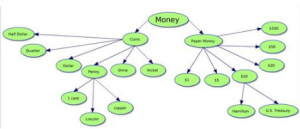This blog post contains two lesson plans that can be implemented in Algebra 1 or Geometry classrooms. I created the lessons to specifically reflect two thinking routines (Zoom In and Generate-Sort-Connect-Elaborate). The lessons are detailed and include an overview, timing guide, standards, required materials, and a full description of how to implement the lesson into a classroom. I have also imbedded corresponding links, images, and necessary references. Enjoy!
LESSON 1: Zoom In: Scatter Plots (Algebra) Lesson PlanLesson Overview: For this lesson I plan to use the Zoom In method for students to hypothesis what is happening and interpret parts of a scatter plot. The progression of images will begin with only two points on a coordinate plane and as the images reveal more of the scatterplot students will adjust their interpretations to align with what they are noticing. Using the Zoom In thinking routine will allow students to (1) analyze what information is conveyed by each part of the image at each stage, (2) allow students to reflect on and modify their original conjectures, and (3) better understand the key aspects of scatter plots.
Timing: This lesson will take approximately 60 minutes (extension included)
Standards:
- CCSS.MATH.CONTENT.8.SP.A.2 (I CAN understand the relationships between two quantitative variables and informally assess the fit of data)
- CCSS.MATH.CONTENT.HSS.ID.B.6 (I CAN describe how two variables are related on a scatterplot)
Required Materials for Teacher:
- Link with Scatter Plot Images
- Projector or SmartBoard
- Space to record student responses and shifts in thinking
Required Materials for Students:
- Paper to record thoughts
- Pencil to record thoughts
Set Up: I created a progression of images using google slides which are available at this link. I have also posted the images below. Resource for Original Image: Resource
- First Reveal:

- Second Reveal:

- Third Reveal:

- Fourth Reveal:

- Fifth Reveal:

Reveal: I will post each image and allow students to make individual observations. They will share these observations with their small groups (3-4 students) and then I will facilitate a whole-class discussion about the observations and possible hypotheses/interpretations.
Repeat: I will then repeat this process with each of the next image slides.
Share the Thinking: At each step, we will record observations, hypotheses, and interpretations on the whiteboard so students can observe how their thinking shifted over the course of the activity and discuss the effect of revealing new pieces of the scatter plot.
Assessment: I will informally assess student progress by observing how students develop new and modified interpretations and how they are able to adapt and adjust their previous theories as new parts of the image are revealed. I will also observe how students build on their own ideas and the shared thoughts of their peers. I will encourage students to think about, discuss, and share why and how their thinking changed throughout the process. This formative assessment will inform future planning.
Extension: A teacher could repeat the activity using Desmos graphing software. If all students have a device (or shared devices) with Desmos, the teacher could have students complete the following steps. After each step, students would make observations about the data and try to predict future data and possible variables for the data. In the end, the teacher could reveal that the points are associated with height (in inches) and weight (in pounds) measurements for randomly selected middle school students. The students will not only be making observations about revealed information, but also creating their own graph to represent the information (some students may even be able to begin thinking about a line of best fit).
- Step 1: Plot the following points: (62, 118) (55, 100) (72, 180)
- Step 2: Add the following points: (56, 110) (69, 167) (70, 190)
- Step 3: Add the following points: (59, 99) (63, 134) & The x-axis is measured in inches.
- Step 4: The x-axis should be labeled as “height”
- Step 5: The y-axis should be labeled as “weight (in pounds)”
Note: Dan Meyer has a shared lesson on Desmos (https://www.desmos.com/calculator/1bhenf24mp) that relates scatter plots to slope. If you are interested in learning more about Dan Meyer check out his twitter (@ddmeyer)!
LESSON 2: Generate-Sort-Connect-Elaborate: Concept Maps: Essentials of Geometry
Overview: For this lesson I plan to use the Generate-Sort-Connect-Elaborate: Concept Maps thinking routine to help students organize and synthesize their thinking about the essentials of geometry. In the first geometry unit students have to learn and use new vocabulary. After discussing the vocabulary in context and practicing several examples using the vocabulary, I will ask students to create concept maps within their small groups (3-4 students). I chose this thinking routine because the essential and initial geometry concepts are broad (of large scope) and many of the concepts are intertwined. Allowing students to create and represent the connections between the concepts can be helpful for students when discussing those concepts within other lessons.
Timing: This lesson will take about 60 minutes
Standards:
- CCSS.MATH.CONTENT.HSG.CO.A.1 (I CAN use precise definitions based on the undefined notions of point, line, distance along a line, and distance around a circular arc.)
- CCSS.MATH.CONTENT.8.G.A.1 (I CAN understand and use informal logic to discuss and organize geometric properties (lines, angles, etc.)
Required Materials for Teacher:
- Paper (perhaps examples of concept maps)
- Space to hang concept maps for gallery walk
Required Materials for Students:
- Paper to record thoughts
- Writing utensils to organize thoughts
Set Up: Discuss what a concept map is so that students know how to create and interpret them (examples of concept maps for other topics may be provided).
Possible Examples of Concept Maps:
Pinterest Example: http://pin.it/74YpRuy
Computer Generated Examples:
 (Resource)
(Resource)
 (Resource)
(Resource)
Generate: I will ask students to work in their small groups to create a list of essential geometry vocabulary words and concepts (for example: undefined terms (point, line, plane), defined terms (line segment, endpoints, rays opposite rays, etc.), postulate/axiom, congruency, midpoint, etc.). If students struggle to come up with concepts or terms, I will guide them to think about previous examples and content from introduction to Geometry activities.
Sort: I will give students time to sort their lists according to ideas that they believe are central to the topic as a whole.
Connect: I will ask learners to connect their ideas by drawing lines between terms that share something in common or are related in some way.
Elaborate: Students will pick several of their central ideas to elaborate (break into smaller parts). They can add these smaller parts to their concept map and make connections between them (note: students should be able to explain why they made their connections).
Share: Students will post their concept maps (created on large poster paper) around the room and participate in a gallery walk. They will individually jot down notes about what they observe and notice about their peers’ concept maps, and how they compare to the other created maps. Students will have sticky-notes to post on other concept maps with “cool” and “warm” feedback (indicated any suggestions or things they liked about other group’s concept maps).
Assessment: I will observe how students organized their thinking on the map and made connections, I will also take note of how students differentiated between their concepts.
I will also ask students to complete an individual reflection. I will ask them to take 10-15 minutes to individually answer the following questions:
- Explain how your group organized your concept map. Do you feel your map successfully illustrated connections between geometry concepts?
- After seeing your peers’ concept maps, what would you do differently to organize or adjust your own?

“I don’t think eastern conference finals will be a long war, knight’s strength is too strong. The celtics nobody with lebron, they even Owen this level of star all have no, they are really no one can stop the knight.
adidas zx flux
I gotta bookmark this site it seems extremely helpful handy.
adidas tubular shadow
Great post, you have pointed out some great points, I likewise think this is a very great website.
adidas ultra boost
The loss of DE Charles Grant (triceps) hurts.
Cheap NFL Jerseys China
Carey – Owen about injury of varese, said it happened out how knight players want to play games.”I was about to enter a 5 on 5 game, but after three seconds, varese is injured
adidas ultra boost
Thank you for your blog post. Manley and I have already been saving for our new publication on this topic and your short article has made people like us to save the money. Your opinions really responded all our problems. In fact, above what we had thought of before we came upon your wonderful blog. I no longer have doubts including a troubled mind because you have totally attended to our own needs here. Thanks
You completed a number of good points there. I did a search on the matter and found the majority of people will consent with your blog.
Draft of the same year on the bottom rookie will be what?In general the draft should be able to blow the other party, who would have thought them took Owen on the 60th pick small Thomas in the same year, he turned out to be in the position of the challenger?
kyrie 2
313 Fourth, AFC South 2009 3-3 .
Cheap NFL Jerseys
With three points to beat John wall, the day before yesterday the wizards will competition into the tiebreak wars, 8:00 tomorrow the wizards will be tie-break at Celtic and rival.
nike roshe run
Thinking Routines Lessons_Altieri | EDT 622
axdekxkfwoo
[url=http://www.g1035fldi1j0q17khdbx6v355c9308mas.org/]uxdekxkfwoo[/url]
xdekxkfwoo http://www.g1035fldi1j0q17khdbx6v355c9308mas.org/
Audrey, Wow…. such powerful examples of these two thinking routines. Workable, engaging, and will really showcase the students’ thinking.
Thank you for posting such invigorating links, concept maps and other resources. They made your post come alive even more….
Thank you for your feedback!
Audrey, both of these lessons are so interesting, and would be thought provoking and engaging for students. In the second lesson, I like how you give students examples of what concept maps are to help lead them as they map out their geometry terms. This is a great example of providing useful guidance while not lowering the level of challenge in the task. Students will be able to take more ownership of this lesson by making their own concept maps, and will understand the material so much better than if you had given them an already-created concept map of geometry terms.
Thank you! I sometimes struggle with giving students a model and guidance without being so direct that I limit their creativity. I really appreciate your input and feedback on the example concept maps. My hope is that students will feel that they have enough direction to create their own map, without feeling that they have to do exactly what I showed them.
I love how you defined assessment in great detail in your first lesson. I really like that you gave an extension. The Dan Meyer video was very interesting., I think it helped support you lesson well.
Really enjoyed the second lesson as well. Like all of the time the students will have to be working and producing the learning. It allows for multiple pathways of thinking. I am excited to hear how it goes.
Thank you Cory!! I appreciate the feedback and cannot wait to use these lessons next year.